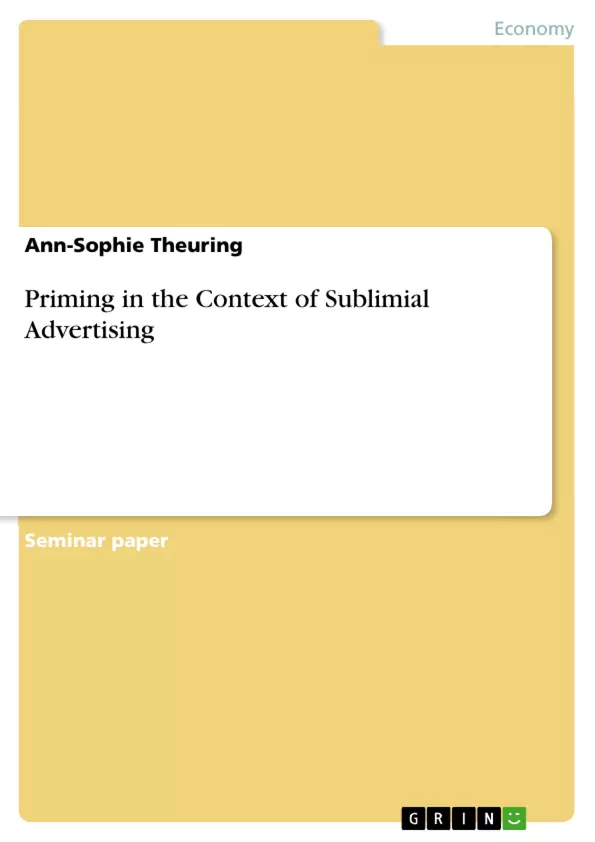Some consumers are frightened by the thought of being influenced to buy something without noticing it. They assume that there are hidden messages in commercials that trick them into buying certain products.
Those subliminal messages can be related to the psychological construct of the priming effect. But can marketing experts really influence their consumers through hiding the priming effect in their advertisements?
To gain insight into the influence of priming in marketing strategies, one needs to understand the meaning of the effect.
The priming effect described a chain reaction of two different stimuli: The first stimulus, also called prime stimulus, influences the cognition of the so called target stimulus through activating the implicit knowledge of the proband.
Table of Contents
- 1. Introduction
- 2. Definition
- 3. Subliminal Advertising
- 4. Conclusion
Objectives and Key Themes
This seminar paper aims to explore the impact of priming, specifically subliminal advertising, on consumer behavior. It examines the definition and mechanics of the priming effect, investigating how it might be utilized in marketing strategies.
- The definition and mechanism of the priming effect.
- The role of Stimulus Onset Asynchrony (SOA) in priming.
- The application of priming in subliminal advertising.
- The ethical considerations surrounding the use of subliminal messaging.
- Consumer awareness and susceptibility to priming techniques.
Chapter Summaries
1. Introduction: This introductory chapter sets the stage for the paper by discussing the public's apprehension towards subliminal advertising and its connection to the psychological concept of priming. It poses the central question of whether marketers can effectively influence consumers through hidden priming effects in their advertisements, establishing the focus and scope of the subsequent analysis.
2. Definition: This chapter delves into a detailed explanation of the priming effect, describing it as a chain reaction involving a prime stimulus influencing the perception of a target stimulus by activating implicit knowledge. It uses examples such as word association to illustrate this concept. The chapter emphasizes the importance of Stimulus Onset Asynchrony (SOA) in determining whether priming is automatic (subliminal, SOA < 500 milliseconds) or strategic (conscious, SOA > 750 milliseconds). The explanation provides a crucial foundation for understanding the mechanisms behind subliminal advertising explored in later sections. It lays the groundwork for understanding how the speed of presentation impacts the consumer’s awareness and subsequent response.
Keywords
Priming, subliminal advertising, consumer behavior, Stimulus Onset Asynchrony (SOA), implicit knowledge, marketing strategies, automatic priming, strategic priming.
Frequently Asked Questions: A Comprehensive Language Preview
What is the main topic of this document?
This document provides a comprehensive preview of a seminar paper exploring the impact of priming, specifically subliminal advertising, on consumer behavior. It covers the definition and mechanics of priming, its application in marketing, and related ethical considerations.
What are the key themes explored in the seminar paper?
Key themes include the definition and mechanism of the priming effect, the role of Stimulus Onset Asynchrony (SOA) in priming, the application of priming in subliminal advertising, the ethical considerations of subliminal messaging, and consumer awareness and susceptibility to priming techniques.
What is the purpose of the seminar paper?
The seminar paper aims to investigate whether marketers can effectively influence consumers through hidden priming effects in advertisements. It explores how the priming effect works and its potential use in marketing strategies.
What is the definition of priming as discussed in the paper?
Priming is described as a chain reaction where a prime stimulus influences the perception of a target stimulus by activating implicit knowledge. The speed of presentation (SOA) is crucial: automatic (subliminal) priming occurs with SOA < 500 milliseconds, while strategic (conscious) priming occurs with SOA > 750 milliseconds.
What is the significance of Stimulus Onset Asynchrony (SOA)?
SOA (Stimulus Onset Asynchrony) determines whether priming is automatic (subliminal) or strategic (conscious). A shorter SOA (<500 milliseconds) indicates subliminal priming, while a longer SOA (>750 milliseconds) suggests conscious processing.
What are the ethical considerations discussed regarding subliminal advertising?
The preview mentions ethical considerations surrounding the use of subliminal messaging, suggesting this is a significant aspect explored in the full paper.
What is covered in each chapter of the seminar paper?
Chapter 1 (Introduction): Sets the stage by discussing public apprehension towards subliminal advertising and its connection to priming. It poses the central research question. Chapter 2 (Definition): Provides a detailed explanation of the priming effect, including its mechanisms and the role of SOA. Chapter 3 (Subliminal Advertising): This chapter is implied but not fully detailed in the preview. It likely explores the application of priming in subliminal advertising. Chapter 4 (Conclusion): Summarizes the findings and likely offers concluding remarks.
What are the keywords associated with the seminar paper?
Keywords include: Priming, subliminal advertising, consumer behavior, Stimulus Onset Asynchrony (SOA), implicit knowledge, marketing strategies, automatic priming, and strategic priming.
What is the overall structure of the document preview?
The preview includes a table of contents, objectives and key themes, chapter summaries, and keywords, providing a comprehensive overview of the seminar paper's content and structure.
- Quote paper
- Ann-Sophie Theuring (Author), 2018, Priming in the Context of Sublimial Advertising, Munich, GRIN Verlag, https://www.grin.com/document/457675



